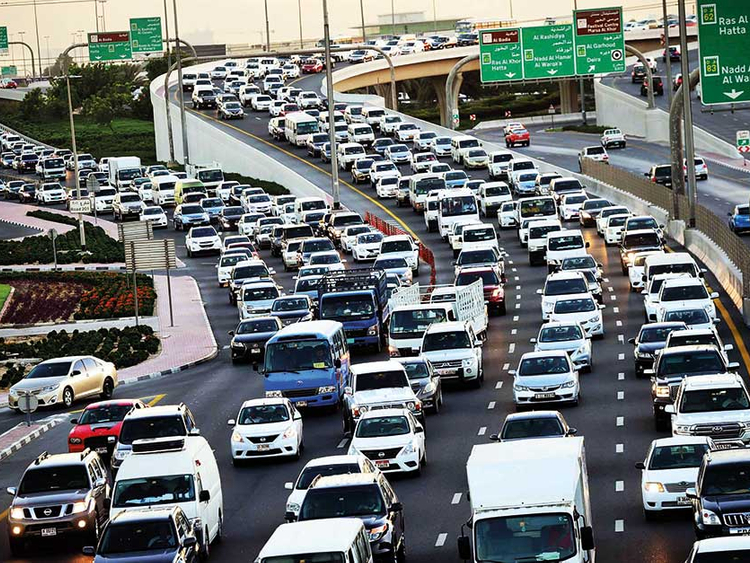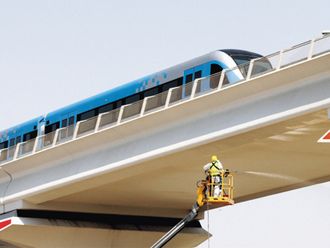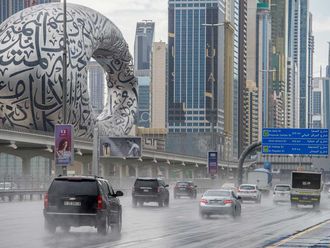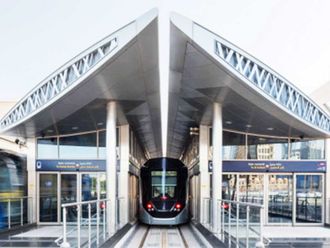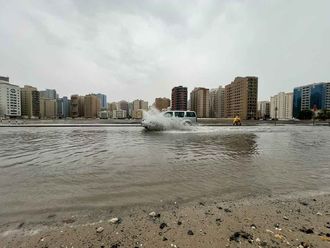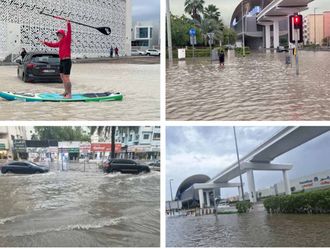Dubai: Syed Suhail, a resident of Al Qusais, who commutes for nearly 100km daily, spends about three hours in traffic that at time seems to barely move.
“We keep seeing the initiatives [to improve traffic flow] and with each new addition of infrastructure, it seems we can hope for less congestion but it has not made any difference to traffic [in some areas]. I know a lot is being done but it just doesn’t seem to be enough,” Suhail said.
Khalid Armar, a resident of Al Baraha in Deira, is perplexed by the ever-growing tailbacks and increasing number of locations that get clogged every passing day, week and month on Dubai roads.
“Where do all these vehicles suddenly appear from and where do they vanish on some days? On weekdays, when there is neither any reason for a sudden increase or decrease in traffic, we come across these crests and troughs, more crests than troughs. It just doesn’t make sense,” said Armar, who drives 40km daily to and from work during peak traffic.
Like Suhail and Armar, many motorists are looking for the root cause of the traffic congestions in Dubai.
Where does the problem lie?
A closer look at Dubai’s traffic growth pattern and the continuous influx in the number of vehicles shows that Dubai has become a victim of its own success.
As Dubai continues to attract foreign workforce every day, meaning more people are entering the city than leaving, more cars hit the roads daily.

A city of around 3 million, Dubai is home to 1.7 million vehicles, up from 700,000 in 2006, a steep increase and a disproportionate level of vehicle density even for a city with some of the world’s best road networks.
And despite the best efforts of the Roads and Transport Authority (RTA), which has almost doubled the road network from 8,715 lane-kilometre in 2006 to 13,594 lane-kilometre in 2016, the traffic bottlenecks don’t seem to ease up.
Now, with Dubai gearing up for Expo2020, we can only expect a higher growth in traffic.
8 of Dubai's traffic hot spots
Do any of these places look familiar?
We look at the top 8 areas where bottlenecks and traffic jams are commonplace

Rebat Street: Traffic heading towards Airport tunnel from Rebat street on the way to Sharjah

Dubai Marina Metro Station: Evening rush hour vehicles entering the area
from Shaikh Zayed road face major tailback. (Photo: Arshad Ali/Gulf News )

Manama Street: Manama Street exit point at International City. Flyovers/underpasses are being built.
 Shindagha Tunnel: The tunnel is expected to be replaced by a major bridge soon. (Photo: Ahmed Ramzan/Gulf News)
Shindagha Tunnel: The tunnel is expected to be replaced by a major bridge soon. (Photo: Ahmed Ramzan/Gulf News)
 Abu Hail: Traffic converges from Abu Hail, Salahuddin road south and service road from Al Khabaisi. (Photo: Atiq ur Rehman/Gulf News)
Abu Hail: Traffic converges from Abu Hail, Salahuddin road south and service road from Al Khabaisi. (Photo: Atiq ur Rehman/Gulf News)
 Al Maktoum Bridge: Part of the problem is traffic merging from six tracks into two in tunnel under Clock Tower.
Al Maktoum Bridge: Part of the problem is traffic merging from six tracks into two in tunnel under Clock Tower.
 Mohammad Bin Zayed Road: Traffic builds on Shaikh Mohammed Bin Zayed Road-Al Ain road exit during evening. (Photo: Clint Egbert/Gulf News)
Mohammad Bin Zayed Road: Traffic builds on Shaikh Mohammed Bin Zayed Road-Al Ain road exit during evening. (Photo: Clint Egbert/Gulf News)
 Deira City Centre: Traffic at Deira City Centre during evening rush hour. (Photo: Arshad Ali/Gulf News)
Deira City Centre: Traffic at Deira City Centre during evening rush hour. (Photo: Arshad Ali/Gulf News)
What can be the solutions?
 |
Engineer Maitha bin Udai, CEO of RTA Traffic and Roads Agency |
Maitha Bin Adai, CEO of Traffic and Roads Agency at RTA, said, “A general comparison of traffic count over the last couple of years has shown a significant increase in vehicles on roads at a rate higher than maximum growth factor typically used for day to day planning. The situation demands additional measures which RTA is currently undertaking.”
5 major projects underway
The RTA is currently working on at least five major infrastructure projects that it hopes will make a big difference to the way the city moves.
“We are currently working on several mega road projects like the Airport Road expansion, Umm Al Shief Road Al Quoz link, the Shindagha Corridor, the International City Interchange as well as the proposed connection between Mohammad Bin Zayed Road and and Emirates Road via Tripoli Road. I believe the Airport road and the Tripoli Road projects, in particular, will help divert the traffic to the Emirates road, where a new interchange is being built to remove the bottleneck towards Sharjah, easing congestions on other main arteries,” said Bin Adai.

Population growth and challenges
According to RTA, over the past decade, Dubai has spent about Dh90 billion on upgrading the infrastructure and transport network in the emirate, including Dh60 billion on roads.
 |
Mattar Al Tayer, Director-General and Chairman of the Board of Executive Directors of Roads and Transport Authority |
However, exponential rise in population continues to make all the expenditure seem insufficient.
“We are facing multiple challenges towards achieving our goal of becoming a truly smart city. One of the challenges we face is the phenomenal rise in population in Dubai, which is growing at 7 per cent, which also reflects in the rise of vehicles on roads and the growing traffic,” said Mattar Al Tayer, Chairman of the Board and Director General of RTA.
Dubai residents talk of traffic woes

 Bottlenecks in certain areas have a spillover effect, causing long tailbacks, but more than that, I feel driving indiscipline adds to motorists’ woes. “I face bottlenecks every day on Hessa street on Al Manama road where people cut in from different sides to access the exits.”
Bottlenecks in certain areas have a spillover effect, causing long tailbacks, but more than that, I feel driving indiscipline adds to motorists’ woes. “I face bottlenecks every day on Hessa street on Al Manama road where people cut in from different sides to access the exits.”
- Mohammad Abu Taleb, 28, Egyptian

 RTA has done a great job in building a modern infrastructure. I do face a few traffic jams on a daily bais but that is part of the big city life. “Without RTA’s efforts in building these new flyovers and bridges the traffic situation would have been worse.”
RTA has done a great job in building a modern infrastructure. I do face a few traffic jams on a daily bais but that is part of the big city life. “Without RTA’s efforts in building these new flyovers and bridges the traffic situation would have been worse.”
- Naveed Kobatte, 35, Indian

 Most people work in one part of Dubai and live in the other or in the northern emirates, which results in all of them heading in one direction at the same time, to and fro. “I think authorities should focus on creating more affordable residential neighbourhoods attached to commercial clusters, which could help disperse traffic.”
Most people work in one part of Dubai and live in the other or in the northern emirates, which results in all of them heading in one direction at the same time, to and fro. “I think authorities should focus on creating more affordable residential neighbourhoods attached to commercial clusters, which could help disperse traffic.”
- Calvin Royo, 34, Filipino

 Despite infrastructure development, the traffic situation has remained the same. I still spend more than four hours daily driving to work from Ajman to Dubai and back. “We expected the Mohammad Bin Zayed road expansion to ease the situation but there has been no significant impact.”
Despite infrastructure development, the traffic situation has remained the same. I still spend more than four hours daily driving to work from Ajman to Dubai and back. “We expected the Mohammad Bin Zayed road expansion to ease the situation but there has been no significant impact.”
- Farook Lampeth, 40, Indian
Sharjah-Dubai daily commute: Residents talk of experiences
Mohammad Waqas sets off from his home in Sharjah at 6.30am daily and returns around 7.30pm after a 13-hour day, four of which are spent in negotiating traffic that he gets stuck in on his way to work and back.
The 35-year old is among thousands of expatriates who work in Dubai and live in Sharjah, but have to suffer additonal hours of traffic for it.
Waqas, a Pakistani expat, lives in the Muweilah area of Sharjah near the National Paints Interchange and takes the Mohammad Bin Zayed Road to travel to and from his office, which is located in Dubai Investment Park (DIP).
A 70km distance that under normal circumstances should not take more than 45 minutes to cover, takes Waqas more than double the time during peak hours.
“In the morning, I start around 6am and reach office just before 8am when my office hours start, but it is the evening traffic that causes real frustration; sometimes, it takes more than two hours to reach home,” said Waqas, who works as an accountant.
He is pinning his hopes on the concerted efforts by the authorities who are sparing no effort in expanding and updating the road infrastructure year by year.
“We can see that a lot is being done by the authorities, but with more people coming to the UAE, the problem keeps getting bigger,” said Waqas. “But with the work on connecting Mohammad Bin Zayed road with Emirates road and the new interchange on the Emirates giving better access to Sharjah, there might be some relief for us,” he said.
Unlike Waqas, 38-year-old Zubai Haider, an assistant marketing manager in a Dubai-based firm, has been born and brought up in Sharjah and has lived there all his life.

 I have been spending several hours of the day daily commuting between Sharjah and Dubai since my school days. It has become a part of my routine now. To make it easier, I stop, take a break with a cup of tea before driving back in the return trips to Sharjah.”
I have been spending several hours of the day daily commuting between Sharjah and Dubai since my school days. It has become a part of my routine now. To make it easier, I stop, take a break with a cup of tea before driving back in the return trips to Sharjah.”
- Zubair Haider, 38 Pakistani
As someone who has seen the worst of Dubai-Sharjah traffic in earlier times, Haider has gotten used to the daily crawl.
“I have lived all my life in Sharjah and have been doing the daily trips to Dubai for decades now. At one time, I used to work in Dubai Media City and I live in Rolla and it used to, mostly, take me more than three hours one way. Like many people [who do this trip], I used to sleep in the car.” But Haider believes the situation has improved. “It is comparatively better now,” he said.
Haider now lives at the Sharjah Industrial Area 6 and works in Business Bay, so his daily commute has gotten shorter but he still has to spend between 90 minutes and two hours one way, depending on when he leaves.
“I usually take the Business Bay Crossing onwards to Airport tunnel. I don’t often try different routes, I think all the routes are more or less the same. I take a short break in between, get a tea and relax a bit, it’s easier [to cope] that way,” added Haider.
According to Haider, the main reason for the daily tailbacks is the inflexible office timing of almost all companies.
“I think office hours should be flexible and that could be one of the ways to tackle the issue. Right now, everybody is on the road at the same time. If the timings are staggered, then traffic will be distributed over a longer period of time, reducing congestion,” he added.
Traffic experts agree that staggered office hours could be one of the solutions that could lead to a significant reduction in congestion on the highways connecting the two emirates.
Experts' suggestions and solutions
One of the reasons why Dubai’s massive expenditure on infrastructure seems insufficient could be the increasing number of vehicles. However, experts suggest another possibility: planning in isolation.
In other words, given that a major portio of Dubai’s traffic is linked to Sharjah and the northern emirates, infrastructure planning should happen in coordination with the neighbouring emirates, they said. Planning in Dubai specific terms may not yield the desired results if the quality of infrastructure in other emirates connected to it is not on par.

 There are many regional interdependencies across the emirates. As such, implementing traffic infrastructure without taking into consideration the contributory factors is not going to lead to any significant longterm benefits.”
There are many regional interdependencies across the emirates. As such, implementing traffic infrastructure without taking into consideration the contributory factors is not going to lead to any significant longterm benefits.”
- Dr Zulfiqar Ali | Traffic engineer
“UAE is interlinked and there is a great deal of regional inter-dependencies across the emirates. As such, implementing traffic management infrastructure without taking into consideration the contributory factors and root causes is not going to lead to any significant long-term benefits,” said Dr. Zulfqar Ali, a London-based traffic engineer and a regular feature in Dubai’s annual traffic and transport related conferences.
“A planning process disassociated from such aspects will only achieve a congestion further down the line by transferring the problem elsewhere along the strategic routes,” he said.
Dr Ali added that the cost of delays due to congestion in terms of economy, environmental impact and driver frustration are the key drivers to assess transport infrastructure planning across the region.
“Studies and assessment need to be done collectively across the emirates to ensure future transport plans are developed based on understanding of regional policies, their impact on transport network and having a collective and co-ordinated approach in managing and controlling growth in traffic,” he said.
He emphasised the importance of having integrated transport plans and strategies that look at all possible modes of transport and not just the vehicular movements.

 A multi-modal approach is recommended to ensure travel choices are available to all residents and visitors. This includes roads but is also to be supplemented with public transit provision such as metro, bus, marine, car sharing, carpooling, and newer modes of transport.”
A multi-modal approach is recommended to ensure travel choices are available to all residents and visitors. This includes roads but is also to be supplemented with public transit provision such as metro, bus, marine, car sharing, carpooling, and newer modes of transport.”
- Martin Tillerman | Traffic engineer
Martin Tillman, director, Strategic Planning and Advisory, at Aecom, a major international transport engineering firm, concurs with Dr Ali’s viewpoint.
“A multi-modal approach is generally recommended to ensure travel choices are available to all residents and visitors. This includes roads but is also to be supplemented with public transit provision such as metro, bus, marine, car sharing, carpooling, and relatively newer modes of transport such as Bus Rapid Transit and Group Rapid Transit, all potentially using alternative fuel types such as electric power. It is also important to recognise that all trips begin and end with walking and to encourage provision of walkways with shading if possible,” said Tillman, who is based in Dubai and is also a regular feature of the transport expert panels of most conferences in the city.
He suggested that Dubai could use certain congestion relief concepts as short-term immediate solutions like use of hard shoulder during peak hours, variable speed limits as well as staggered working and school hours.
“Congestion relief concepts at various stages of testing around the world include ramp metering which restricts access to freeways at peak times, peak shoulder running which is the use of the hard shoulder for general traffic, and variable speed limits which can help to increase capacity by reducing headways at busy times to increase throughput. Another concept is staggered working and school hours to spread peak demand over a longer period of time,” he added.
Congestion relief concepts
Short-term immediate solutions
Use of hard shoulder during peak hours,
Variable speed limits
Staggered working and school hours
Long-term congestion relief concepts
Multi-modal approach with public transit provision such as metro, bus, marine, car sharing, carpooling.
Relatively newer modes of transport such as Bus Rapid Transit and Group Rapid Transit


